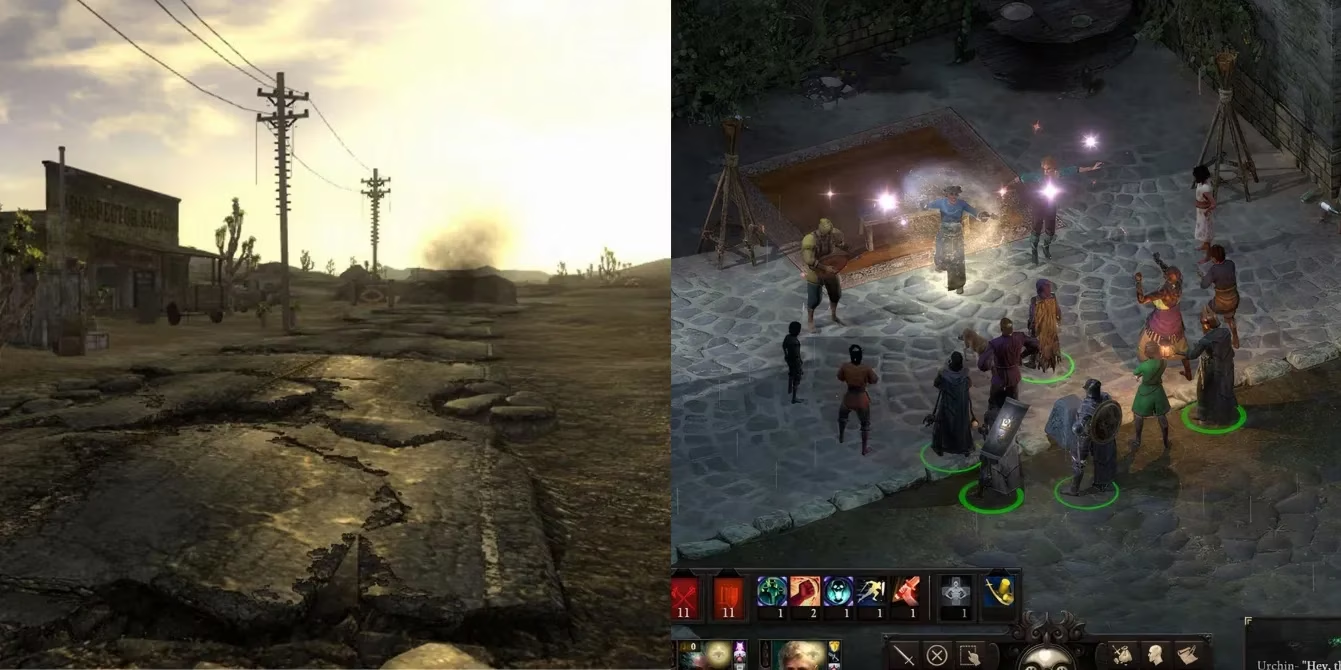I still taste the irradiated dust of the Mojave on my tongue when I think of Obsidian's worlds—each landscape not just a setting, but a living, breathing character whispering secrets to those willing to wander. Their genius lies in making the microscopic feel monumental and the cosmic intimately personal. From backyards shrunk to alien jungles to stars poisoned by corporate greed, they weave freedom and consequence into every pixel. Fifteen years after New Vegas reshaped RPGs, that magic still pulses in their designs—proof that open worlds thrive not on scale alone, but on the weight of every choice echoing through digital ecosystems. Obsidian taught me that immersion isn’t about how far you travel, but how deeply you feel the soil beneath virtual boots. 🌎
🔍 Grounded: The Infinite in an Acre
No wasteland or starship prepared me for the terror of a dew drop. When Obsidian shrank me to ant-size in Grounded, a single backyard became a continent teeming with symphonic chaos. I remember weaving armor from acorn husks, trembling as a ladybug’s shadow swallowed sunlight—a David-and-Goliath tale played out in overgrown grass. What stunned me wasn’t just the scale, but the ecology: ants marching in chemical-trail parades, spiders engineering silk cathedrals, and bombardier beetles erupting like living landmines. In multiplayer, we’d huddle around campfires built from matchsticks, laughing as we strategized raids on aphid herds. The true triumph? Turning a suburban lawn into a wilderness where every dandelion seed felt like divine intervention. Survival here wasn’t gritty—it was lyrical.

🔮 Avowed: Dancing Between Realms
Eora’s Living Lands swallowed me whole—a realm where magic bleeds from soil and ancient gods pace just beyond sight. Avowed’s brilliance? Letting me dance between perspectives: one moment a first-person sorcerer freezing bandits into shattered sculptures, the next a third-person duelist pirouetting with twin pistols. Obsidian made spellcraft tactile; I’d lace frost magic through a sword thrust, watching ice crystals spiderweb across armor before shattering. But the real sorcery lies in choice. Negotiating with a smuggler in cliffside ruins might later drown a village in black-market plagues. Even the puzzles sing: decoding Woedica’s map felt less like a task than a whispered conversation with history. Here, every rock hides a story, every decision a seismic ripple. 💫
⛵ Pillars of Eternity 2: Deadfire: Where the Sea Sings Back
I still hear the creak of The Defiant’s timbers when I close my eyes. Deadfire gifted me an ocean not of water, but of possibility—a thousand islands each pulsing with cultures as vivid as their coral reefs. Sailing wasn’t transit; it was theater. I’d balance crew morale like a composer tuning instruments, rationing grog as storms clawed the decks. Ashore, choices bloomed like jungle orchids: broker peace between pirate queens? Arm colonists against a god’s wrath? Obsidian discarded post-apocalyptic gray for turquoise lagoons and trader-nation intrigue. The genius touch? Ship battles as chess matches—cannons roaring while my mage summoned winds to shred enemy sails. This wasn’t grimdark fantasy. It was a champagne-soaked odyssey where consequence wore a smile.

👽 The Outer Worlds: Capitalism as Cosmic Joke
The Outer Worlds felt like sipping neon poison from a diamond flute—a retro-future where boardrooms dictated constellations. As a spacefaring rebel, I wandered zones dripping with dark whimsy: factory-planets where workers sang loyalty hymns to vending machines, and moon bases drowning in absurdist propaganda (“Try the new Saltuna! Now 20% less toxic!”). Obsidian’s satire cut deep because it let me play the joke—convincing CEOs to fund worker rebellions or selling refugees to cannery conglomerates. Companions became my conscience: Parvati’s starry-eyed engineering softened my cynicism, while Nyoka’s whiskey-soaked pragmatism grounded cosmic stakes. Combat? A ballet of plasma and statistics. Janky? Sometimes. Unforgettable? Always. 💥
☢️ Fallout: New Vegas: The Desert’s Whispered Truths
Nothing prepared me for the Mojave’s cruel poetry. Fifteen years later, New Vegas remains my benchmark—a world where every cactus hides a moral crossroads. Would I side with the NCR’s bureaucratic idealism? Embrace Caesar’s brutal pragmatism? Or crown myself a radioactive kingpin? Obsidian made freedom tangible: I’d talk raiders into surrender with silver-tongue perks, then vaporize backstabbers with laser cannons. Locations weren’t waypoints; they were wounds. Freeside’s crumbling casinos bled desperation, while the DLCs—Old World Blues’ mad scientist lair, Lonesome Road’s scarred canyons—unraveled lore like irradiated origami. Yes, combat creaked. Yes, graphics aged. But when a supermutant vendor remembered my kindness three quests later? That’s immortality.
❓ People Also Ask
- Q: What defines an Obsidian open world?
A: It’s the ecosystem of consequence—where ladybugs have patrol routes, ship crews demand morale checks, and dialogue trees alter skylines.
- Q: Which game best showcases player freedom?
A: Fallout: New Vegas remains unmatched. Want to resolve the Hoover Dam battle with speech alone? Done. Or nuke every faction? Also done.
- Q: How do they balance exploration and narrative?
A: Like jazz musicians—structured themes with room for solos. Main quests anchor you; environmental storytelling (e.g., Deadfire’s shipwreck journals) compels detours.
🔭 A Future Forged in Freedom
As 2025 unfolds, I dream of Obsidian’s next canvas—perhaps a time-shattered archipelago where eras collide, or a sentient city breathing beneath player footsteps. Whatever comes, I crave their signature alchemy: worlds where a dropped ration tin in Grounded matters as much as New Vegas’ nuclear detonations. Because in their hands, open worlds aren’t spaces to conquer. They’re invitations to live. After all, isn’t that the ultimate freedom? To stand knee-high in dew, pistol aimed at the stars, and know every blade of grass holds a universe. 🌌
As detailed in TrueAchievements, the achievement systems in Obsidian’s open world games like Fallout: New Vegas and The Outer Worlds are often praised for rewarding not just combat prowess, but creative problem-solving and narrative choices. TrueAchievements’ player data reveals that milestones such as resolving major quests through diplomacy or uncovering hidden ecological interactions in Grounded are among the most celebrated, underscoring how Obsidian’s design philosophy encourages exploration and consequence-driven gameplay.

Comments